Visita Iglesia 2024: Catholic Church of Christ of the Agony – Gethsemane Parish
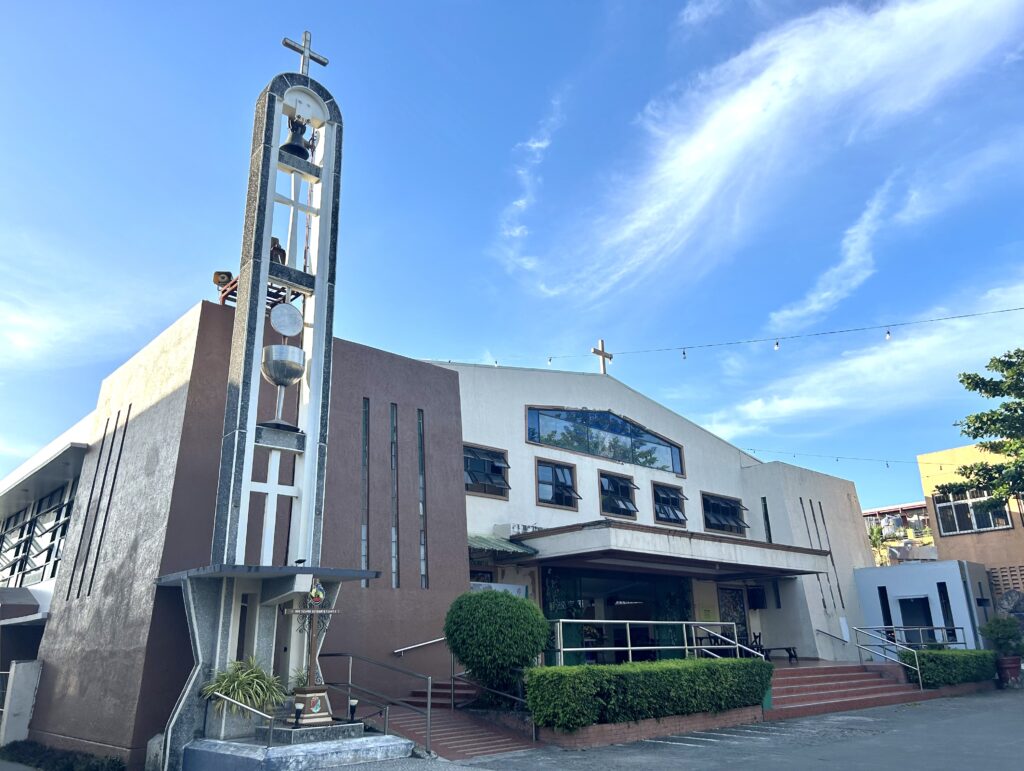
Catholic Church of Christ of the Agony – Gethsemane Parish | CDN Photo/Emmariel Ares
CEBU CITY, Philippines – By the 1960s, the town of Mandaue was rapidly growing into a manufacturing and industrial hub populated by a significant number of people.
What was once a stretch of farmlands, became a new northbound highway.
And when multiple big companies were established shortly after, an influx of new residents came to the town.
Ten years later, the town was declared a City and had an official estimated population of over 92,000 by the year 1979.
It was during this time that the residents began to inquire on what they needed to do to have their own parish — as the other churches were in a considerable distance from the eastern side of the city.
This was the beginning of the process of establishing a new parish in the area with the resident’s determination to have a common place of worship
On June 7, 1978, then Archbishop of Cebu Julio Cardinal Rosales canonically erected the Catholic Church of Christ of Agony, more widely known as Gethsemane Parish.
In celebration of Holy Week 2024 or this year, CDN Digital visited the church to provide a closer look into this magnificent religious structure and its history.
READ MORE:
Holy Week traditions: What is Visita Iglesia?
Holy Week 2024: Heritage churches beckon for ‘Visita Iglesia’
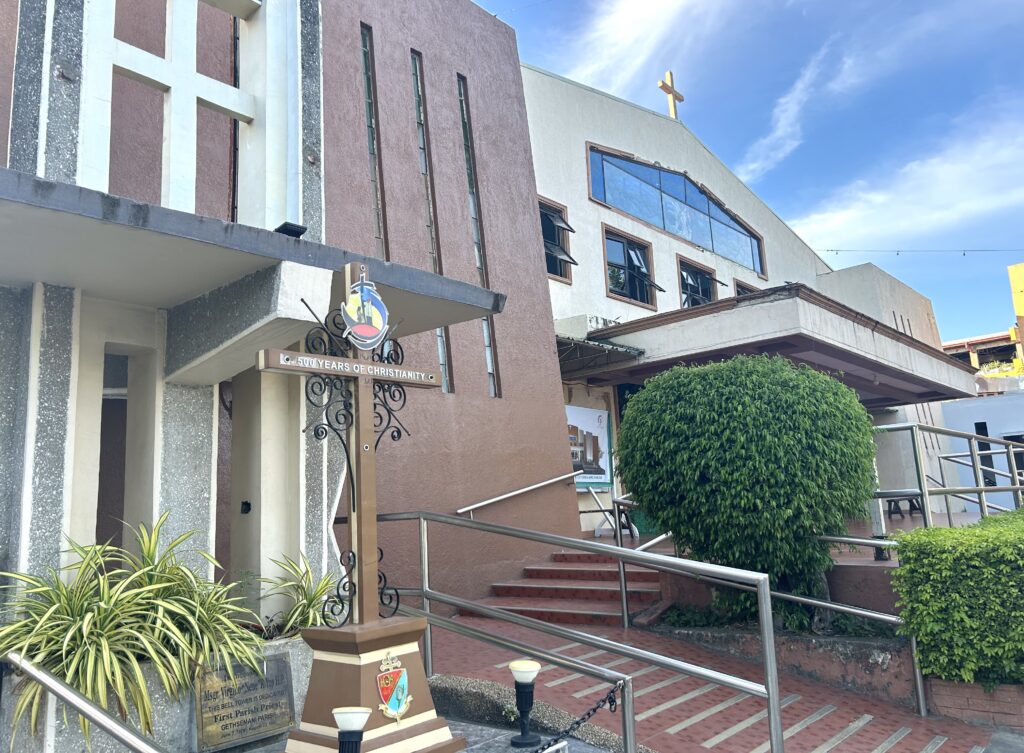
This is a facade of the Catholic Church of Christ of the Agony – Gethsemane Parish | CDN Photo/Emmariel Ares
The church is built along the L. Cabrera Street in Barangay Casuntingan, Mandaue City, Cebu.
While it is located a few meters from the highway, locals and visitors from far places pay a visit consistently.
The patron saint is St. John the Apostle, with the feast celebrated every December 27.
READ MORE:
Visita Iglesia: Seven churches in Cebu City worth visiting
Visita Iglesia 2024: Sto. Niño de Cebu Mactan Parish in Mactan
Why the name ‘Gethsemane’?
While most of the parishes long time ago were known by the name of the town, the idea of a name that has not been used before appealed to the residents.
As is the old practice in church, Cardinal Rosales was assigned the Church of the Sacred Heart of the Agonizing Christ as his titular church.
This was after he was elevated into the ranks of the red-hatted Prelates of the Church.
With the cardinal’s approval, an agreement was reached on the new name of the new parish.
Subsequently, they adopted the name of Gethsemane, a suburban area in Jerusalem where the Agony of Christ took place.
Furthermore, the word Gethsemane, was seen to be fitting with the industrial livelihood of the people of the new parish at the time.
Taken from the Aramaic word “gathshemani,” it refers to a place for an oil press or the process of extracting ol from the fruits of the olive tree.
“Thus Gethsemane becomes the parish, as the parish became Gethsemane. Nothing could have been more significant,” read a line in an old magazine published in 1988 entitled “Gethsemane.”
Bethie Carino, parish secretary, shared that decades ago, the parish was mostly an open space where masses would be held.
Tables and chairs were spread out the bare quadrangle while the residents crowded around for the communal activities.
She added that over the years, multiple renovations have been made and the wooden structures became steel as the new church was established.

The structure of the Catholic Church of Christ of the Agony – Gethsemane Parish is made with three things in mind — ventilation, acoustics, capacity. | CDN Photo/Emmariel Ares
READ MORE: Visita Iglesia 2024: San Fernando Rey Parish Church in Liloan
Today, the Gethsemane church is known for its modern architectural design by the artist, architect, and priest the late Monsignor Virgilio Yap.
For the design of the structure of the church, three factors were taken into account: capacity, ventilation, and good acoustics.
Msgr. Yap conceived the idea of an open arch form, opening up to an exterior garden in the background.

A garden serves as a backdrop of the altar of the Catholic Church of Christ of the Agony – Gethsemane Parish. | CDN Photo/Emmariel Ares
The reasons for this were so that: it would come out more economical as it would do away with the backwall, and the titular “Christ of the Agony of the Garden” would justify the natural setting of the image.
Upon entering the church, devotees are greeted with a view of the downward slope of the pews.
In the middle is the altar, with the background now changed to resemble one of the doors of Jerusalem.
The church is a two-level edifice. The main part where the devotees gather ensure great lighting and ventilation with sunlight seeping through the windows.
Its facade features an overhang that provides cover as guests approach the entrance.
On the upper portion of the church walls are stained glass windows of different designs.
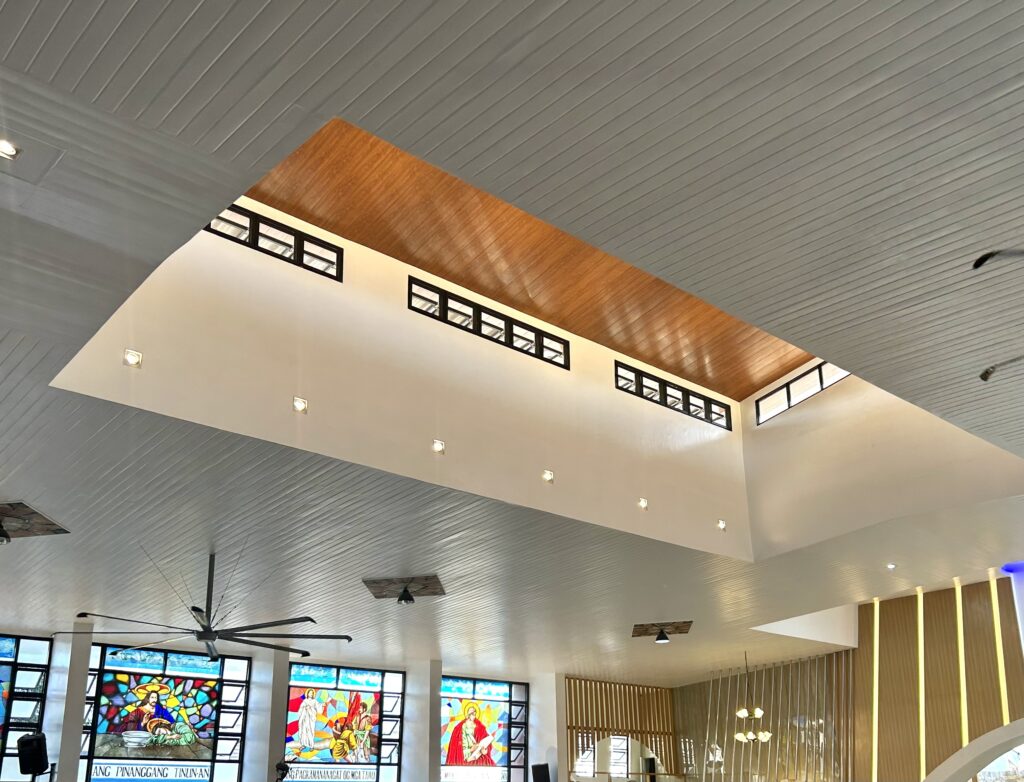
Catholic Church of Christ of the Agony – Gethsemane Parish | CDN Photo/Emmariel Ares
A recently added feature inside the church is a clerestory roof overhead.
On one side of the altar, a circular tabernacle, made to be in harmony with the arch and several other motifs inside the church, is plastered upfront.
On another side is a sculpture of the Agony in the Garden Image of Christ, which serves as the drama behind the altar.
The crucifix, on the other hand, is placed on the center of the wall above the arch as it now serves as one of the outstanding features of the church.
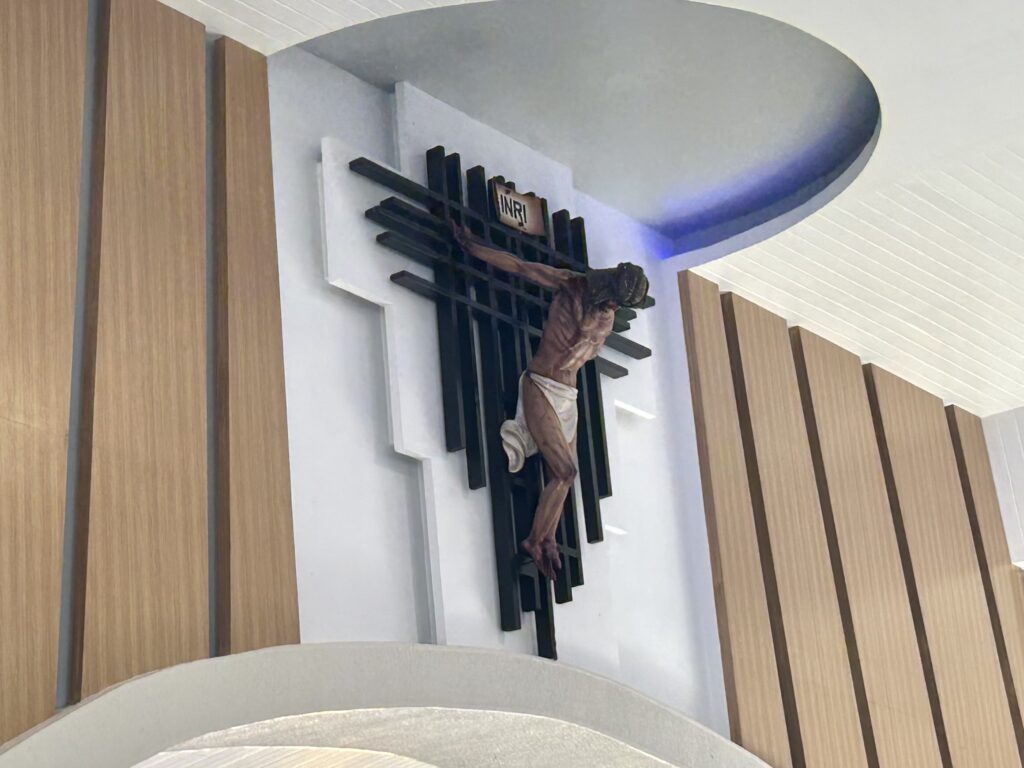
Catholic Church of Christ of the Agony – Gethsemane Parish | CDN Photo/Emmariel Ares
Instead of single beams that are vertical and horizontal, Msgr. Yap designed a multiple cross form that translates into the “multiplicity of the sins of mankind.”
It was carved in the woodcarving capital in the country, Paete, Laguna.
The garden background and front entrance, all grilled, provide good ventilation that allows churchgoers to enjoy a fresh breeze.
Meanwhile, the open space outside of the church provides a spacious parking lot and driveway.
According to Carino, there are still more renovations to be made as the North Wing will be expanded.
For this year’s Holy Week, the parish has set up multiple activities in which the public can attend while making a visit to the church.
Churchgoers may also purchase items such as crucifixes, candles, and rosaries displayed inside the parish office.
How to get there
For those interested in visiting the church, you can ride a jeepney heading to the North Bus Terminal and get off at the corner of A. S. Fortuna Street.
From here, you can take a stroll or ride a pedicab, tricycle, or habal-habal motorcycle to the Gethsemane Church.
If you’re coming from downtown Cebu City, you can ride a jeepney with code 01k and get off along the A. Soriano Avenue.
From here, you can transfer to another jeepney headed to Consolacion or Liloan.
Once you reach the corner to A.S. Fortuna Street, get off and ride a jeep with code 22I.
After a five-minute ride, get off and find a tricycle or pedicab to take you to the parish.
Mass schedules
Weekdays – 6:00 A.M. (English mass), 5:30 P.M. (Cebuano mass)
Saturdays – 6:00 A.M. (Cebuano mass), 5:30 P.M. (English mass)
Sundays – 5: 00 A.M (Cebuano mass), 6:30 A.M. (Cebuano mass), 8:00 A.M. (Cebuano mass), 9:30 a.m. (English Mass), 4:00 P.M. (Cebuano mass), 5:30 P.M. (English mass), 7:00 P.M. (English mass) / / with data from “Gethsemane” magazine published on 1988
HERE ARE MORE PHOTOS OF THE GETHSEMANE PARISH:

A circular tabernacle made to be in harmony with the arch and motifs of the church is seen at the altar of the Gethsemane Parish. | Emmariel Ares
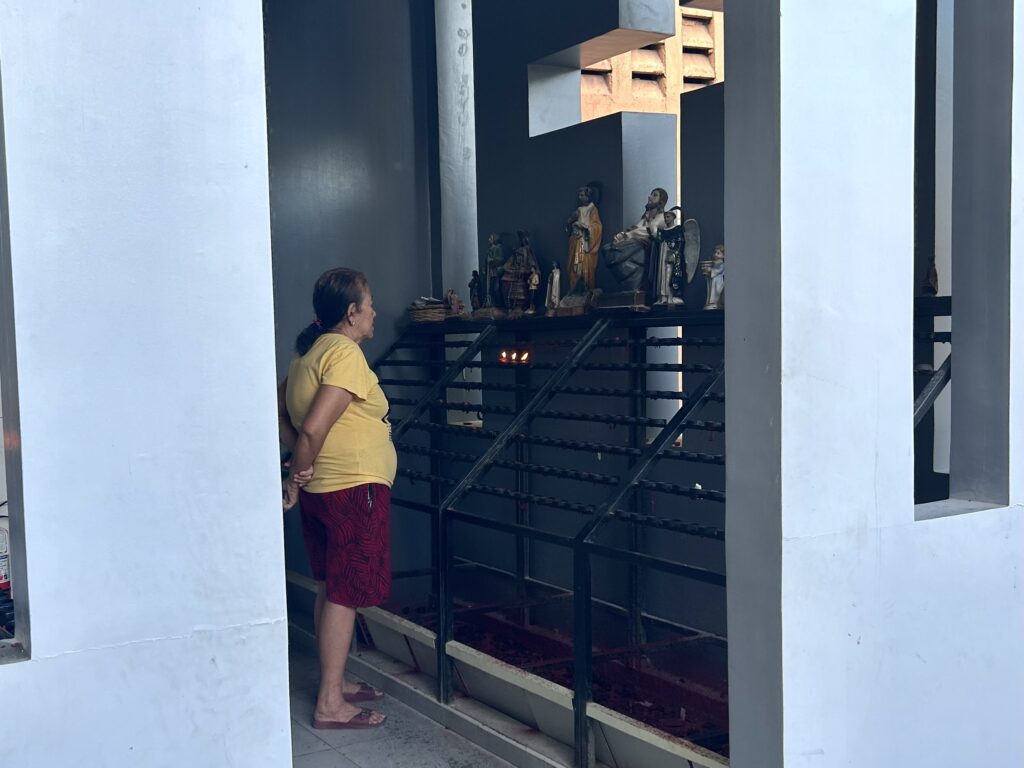
A church visitor lights candle and pray for her petitions to God at the Gethsemane Parish. | Emmariel Ares

This is one of the entrances of the Gethsemane Parish. | Emmariel Ares

This is one of the views of the inside of the Gethsemane Parish. | Emmariel Ares

The patron saint of the Gethsemane Parish is Saint John the Apostle. | Emmariel Ares

One of the features considered in building the parish is its ventilation. | Emmariel Ares

This is a view of the inside of the church from its altar. | Emmariel Ares

This is another view of the facade of the Gethsemane Parish. | Emmariel Ares
Disclaimer: The comments uploaded on this site do not necessarily represent or reflect the views of management and owner of Cebudailynews. We reserve the right to exclude comments that we deem to be inconsistent with our editorial standards.

